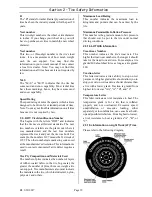
Section 1 – Safety Information
R4 3/30/2017
Page 8
brakes used. When properly adjusted, the trailer
brakes will come on just before the tow vehicle
brakes.
It will take practice to learn how to back up a tow
vehicle with a trailer attached. Take it slow.
Before backing up, get out of the tow vehicle and
look behind the trailer to make sure that there are no
obstacles. Some drivers place their hands at the
bottom of the steering wheel, and while the tow
vehicle is in reverse, “think” of the hands as being
on the top of the wheel. When the hands move to
the right (counter-clockwise, as you would do to
turn the tow vehicle to the left when moving
forward), the rear of the trailer moves to the right.
Conversely, rotating the steering wheel clockwise
with your hands at the bottom of the wheel will
move the rear of the trailer to the left, while backing
up. If you are towing a bumper hitch rig, be careful
not to allow the trailer to turn too much, because it
will hit the rear of the tow vehicle. To straighten
the rig, either pull forward, or turn the steering
wheel in the opposite direction.
1.2.19 Safe Trailer Towing Guidelines
•
Recheck the load tiedowns to make sure the
load will not shift during towing.
•
Before towing, check coupling, safety chain,
safety brake, tires, wheels and lights.
•
Check the lug nuts or bolts for tightness.
•
Check coupler tightness after towing 50 miles.
•
Adjust the brake controller to engage the trailer
brakes before the tow vehicle brakes. Your
dealer can assist you by making this
adjustment.
•
Use your mirrors to verify that you have room
to change lanes or pull into traffic.
•
Use your turn signals well in advance.
•
Allow plenty of stopping space for your trailer
and tow vehicle.
•
Do not drive so fast that the trailer begins to
sway due to speed. Never drive faster than 60
m.p.h.
•
Allow plenty of room for passing. A rule of
thumb is that the passing distance with a trailer
is 4 times the passing distance without a trailer.
•
Shift your automatic transmission into a lower
gear for city driving.
•
Use lower gears for climbing and descending
grades.
•
Do not ride the brakes while descending grades,
they may get so hot that they stop working.
Then you will potentially have a runaway tow
vehicle and trailer.
•
To conserve fuel, don't use full throttle to climb
a hill. Instead, build speed on the approach.
•
Slow down for bumps in the road. Take your
foot off the brake when crossing the bump.
•
Do not brake while in a curve unless absolutely
necessary. Instead, slow down before you enter
the curve and power through the curve. This
way, the towing vehicle remains “in charge.”
•
Do not apply the brakes to correct extreme
trailer swaying. The application of the trailer
brakes alone will tend to straighten out the
combination, especially when going downhill.
•
Make regular stops, about once each hour.
Confirm that
•
the coupler is secure to the hitch and is
locked,
•
electrical connectors are made,
•
there is appropriate slack in the safety
chains,
•
there is appropriate slack in the breakaway
switch pullpin lanyard,
•
the tires are not visibly low on pressure,
and
•
the cargo is secure and in good condition.
Содержание COACH TRAILERS
Страница 1: ...COACH TRAILERS OWNER S MANUAL...
Страница 6: ......





























